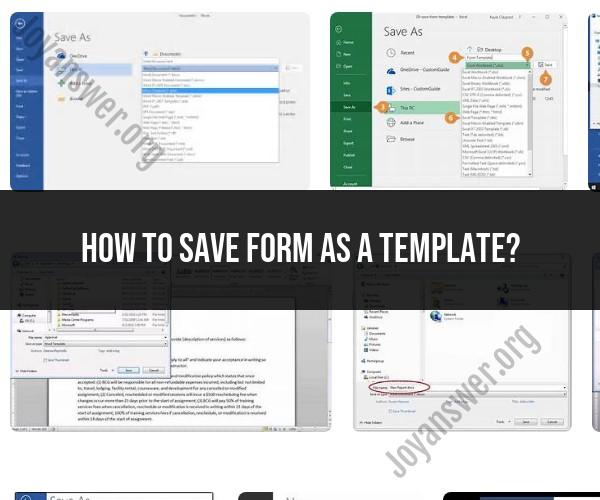How to save form as a template?
Saving a form as a template depends on the software or platform you are using to create and manage forms. Here are general steps that you can follow in common programs like Microsoft Word, Google Forms, and Adobe Acrobat:
Saving a Form as a Template in Microsoft Word:
Open Microsoft Word:
- Launch Microsoft Word and create the form you want to save as a template.
Design Your Form:
- Design your form, including text, questions, and formatting.
Remove Personal Data:
- Remove any personal or specific data that you don't want to include in the template. This ensures that the template is reusable for various purposes.
Save the Form:
- Click on "File" in the top left corner of the Word window and select "Save As."
Choose a Location:
- Select the location where you want to save the form template on your computer.
Choose "Word Template" Format:
- In the "Save as type" or "Format" dropdown menu, select "Word Template" or ".dotx."
Name Your Template:
- Give your template a descriptive name, and click "Save."
Your form is now saved as a template and can be used as a starting point for future forms.
Saving a Form as a Template in Google Forms:
Open Google Forms:
- Go to Google Forms (forms.google.com) and create the form you want to save as a template.
Design Your Form:
- Design your form by adding questions, response options, and formatting.
Click on "Settings":
- In the top right corner, click on the gear-shaped "Settings" icon.
Select "Templates":
- In the dropdown menu, click on "Templates."
Click "Save As a Template":
- A sidebar will appear on the right. Click the "Save as a template" option.
Name Your Template:
- Give your template a name, and choose the appropriate category or folder to save it in.
Click "Save":
- Click the "Save" button to save your form as a template.
You can access this template from the "Template gallery" when creating a new form.
Saving a Form as a Template in Adobe Acrobat:
Open Adobe Acrobat:
- Launch Adobe Acrobat and open the form you want to save as a template.
Edit the Form:
- Make any necessary edits or changes to the form.
Click "File":
- In the top left corner of the Adobe Acrobat window, click on "File."
Select "Save As":
- Choose "Save As" from the dropdown menu.
Choose "PDF Template" Format:
- In the "Save as type" or "Format" dropdown menu, select "PDF Template."
Name Your Template:
- Give your template a name and select the location to save it.
Click "Save":
- Click "Save" to save the form as a template in PDF format.
Now, you have a PDF form template that can be used for future purposes.
These steps may vary slightly depending on the software or platform you are using, but the general process involves saving your form with the appropriate file format and in a designated location for templates.
How to save a form as a template for future use?
The steps to save a form as a template vary depending on the software application you are using. However, here is a general overview:
- Open the form that you want to save as a template.
- Go to the File menu and select Save As.
- In the Save As dialog box, select the Template file type.
- Enter a name for your template file and click Save.
What are the steps to create a reusable form template?
To create a reusable form template, you should follow these steps:
- Design your form with the necessary fields and formatting.
- Add any required instructions or help text.
- Save your form as a template.
When creating a reusable form template, it is important to keep the following tips in mind:
- Use clear and concise labels for all fields.
- Use field validation to ensure that users enter valid data.
- Use conditional formatting to hide or show fields based on the user's input.
- Use repeating sections to allow users to enter multiple sets of data.
- Use formulas to automatically calculate values in fields.
Can you explain the importance of saving forms as templates for efficiency?
Saving forms as templates can significantly improve your efficiency. By using templates, you can avoid having to recreate the same form from scratch each time you need to create a new form. This can save you a lot of time and effort, especially if you frequently create similar forms.
What file formats are suitable for saving form templates?
The most common file format for saving form templates is PDF. PDF templates are compatible with a wide range of software applications and can be easily shared with others.
Other file formats that can be used for saving form templates include:
- DOCX: Microsoft Word document
- XLSX: Microsoft Excel spreadsheet
- PPTX: Microsoft PowerPoint presentation
- ODT: OpenDocument Text document
- ODS: OpenDocument Spreadsheet
- ODP: OpenDocument Presentation
Are there software applications that make it easier to save and manage form templates?
Yes, there are a number of software applications that make it easier to save and manage form templates. Some popular examples include:
- Google Forms
- Microsoft Forms
- JotForm
- Typeform
- Formstack
These applications provide a variety of features for creating, saving, and managing form templates, such as:
- Drag-and-drop form builders
- Pre-built form templates
- Form sharing and collaboration tools
- Form analytics
If you frequently create and manage forms, I recommend using a dedicated form builder application. These applications can save you a lot of time and effort, and they can help you to create professional-looking forms.













